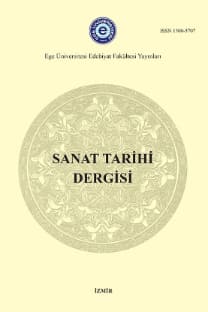Küratörün Söylemi̇ / Çağdaş Sanat Sergi̇leri̇nde Bi̇r Praksi̇s Analizi
THE DISCOURSE OF CURATORS/ A PRAXIS ANALYSIS IN CONTEMPORARY ART EXHIBITIONS
exhibition, artist, biennial, museum, curator, exhibition, artist, biennial, museum,
___
- Altshuler, B. (1998). The avant-garde in exhibition: New art in the 20th century. Los Angeles: University of California Press.
- Baudelaire, C. (2003). Modern Hayatın Ressamı. İstanbul: İletişim Yayınları.
- Bauman, Z. (1998). On art death and postmodernity-And what they do to each other. M. Hannula (Ed.), Stopping the process?: Contemporary views on art and exhibitions. Helsinki: NIFCA.
- Bismarck, V. B. (2011, Eylül). Curatorial criticality-On the role of freelance curators in the field of contemporary art. Sayı:3. https://www.on-curating.org/files/oc/dateiverwaltung/old%20Issues/ONCURATING_Issue9.pdf [Erişim: Mart 2020]
- Ferguson, B. (1992). Curatorial Methodology/Curatorial Conversations: Museum Speech Acts. G. Karamustafa & D. Şengel (Ed.), Bilgi olarak sanat olgu olarak sanatçı. İstanbul: Plastik Sanatlar Derneği.
- Fowle, K. (2007). Who cares? Understanding the role of the curator today. S. Rand & H. Kouris (Ed.), Cautionary tales: Critical curating. Apexart. [Kindle versiyonu] http://www.amazon.com
- Groys, B. (2007). The Curator as Iconoclast. S. Rand & H. Kouris (Ed.), Cautionary tales: Critical curating. Apexart. [Kindle versiyonu] http://www.amazon.com
- Heinich N.; Pollak, M. (2001). Müze küratöründen sergi auteur’üne özgün bir konum icat etmek. Sanat Dünyamız. Sayı:81. İstanbul: Yapı Kredi Yayıncılık.
- Hoffmann, J. (2005). The Next Documenta Should Be Curated by an Artist. New York: e-flux.
- Hopkins. D. (2000). After modern art 1945-2000. New York: Oxford University Press.
- Lee, C.Y. (2007). Curating in a global age. S. Rand & H. Kouris (Ed.), Cautionary tales: Critical curating. Apexart. [Kindle versiyonu] http://www.amazon.com
- Lind, M. (2011, Aralık- 2012, Ocak). To show or not to show. (J. Hoffmann, ropörtaj). Sayı: 31. http://moussemagazine.it/jens-hoffmann-maria-lind-2011/ [Erişim: Haziran 2019]
- Niemojewski, R. (2016). The aspirational narrative of the new curator. The new curator. London: Laurence King.
- Marincola, P. (2011). Introduction: Practice Makes Perfect. What makes a great exhibition (4. Baskı). Philadelphia: Philadelphia Exhibitions Initiative.
- Martinon, J-P. & Rogoff, I. (2013). Preface. (5-8). J-P. Martinon (Ed.), The curatorial- A philosophy of curating. London: Bloomsbury
- Museum Curator. https://www.louvre.fr/en/museum-curator [Erişim: Mart 2020].
- Poshyananda, A. (2001). The acrobat, the chef, the go-between, and the dreamer. (C. Kuoni, Ed.). Words of wisdom: A corator’s vade mecum on contemporary art. New York: ICI.
- Obrist, H.U. (2006). Everyhing You Always Wanted to Know About Curating. New York&Berlin: Sternberg Press.
- O’Neill, P. (2007). The curatorial turn: From practice to discourse. J. Rugg & M. Sedgwick (Ed.), Issues in Curating Contemporary Art and Performance. Bristol: Intellect Books
- O’Neill, P. (2012). The Curatorial Constellation and the Paracuratorial Paradox, The Exhibitionist, 6. (55-60). New York: Archive Books
- Richter, D. (2013, Haziran). Artists and Curators as Authors-competitors, collaborators, or team workers, (43-58). M. Birchall (Ed.), On artistic and curatorial authorship. Sayı 19. https://www.oncurating.org/files/oc/dateiverwaltung/issue19/Print_to_download/ONCURATING_Issue19_A4.pdf. [Erişim: Nisan 2020]
- Rugoff, R. (2011). You talking to me? On curating group shows that give you a chance to join the group. (P.Marincola, ed.). What makes a great exhibition? (4. Baskı). Philadelphia: Philadelphia Exhibitions Initiative.
- Rugoff, R. (2015). Rules of the game. Frieze. https://sherisimons.wordpress.com/2015/09/21/rules-of-the-game-by-ralph-rugoff-on-curatorial-practice/ [Erişim: Ocak 2020]
- Rylands, P. (2009). The story of a museum collection. Peggy Guggenheim Collection. New York: Guggenheim Museum Publication.
- Smith, T. (2012). Thinking contemporary curating. New York: Independed curators international.
- Staruss, D.L. (2007). The bias of the world: Curating after Szeemann & Hopps. S. Rand & H. Kouris (Ed.), Cautionary tales: Critical curating. Apexart. [Kindle versiyonu] http://www.amazon.com.
- Stedelijk Museum. (Haziran, 08, 2020). Stedelijk museum proudly announces. https://www.stedelijk.nl/en/news/stedelijk-museum-amsterdam-proudly-announces-appointment-yvette-mutumba-and-adam-szymczyk-curators-large [Erişim Haziran 2020]
- Storr, R. (2011). Show and tell. (P.Marincola, ed.). What makes a great exhibition? (4. Baskı). Philadelphia: Philadelphia Exhibitions Initiative.
- Storr, R. (2005, 13 Eylül). Reading Circle. (93). Frieze. https://www.frieze.com/article/reading-circle [Erişim: Ekim 2019]
- ISSN: 1300-5707
- Yayın Aralığı: 2
- Başlangıç: 1982
- Yayıncı: Ege Üniversitesi, Edebiyat Fakültesi
Geleneksel Osmanlı Mimarlığı Bağlamında Bir Ankara Ulucanlar Mahallesi Evi
Tülay KAZANCI, İlkay Canan OKKALI
Trabzon Ayasofya Kilisesi Bahçesi’nde Bulunan Figürlü Bir Mezar Anıtı
KUŞADASI, KADIKALESİ KAZISI’NIN 2017-2020 SEZONLARINA AİT BİZANS CAMI ÖRNEKLERİ
Rize Ahşap (Çantı) Camilerinde Bezeme Üslubu
Barok Resimde İsa’nın Havarilerinin Martirdom Sahneleri
Konya Camilerindeki Ahşap Mihraplardan Örnekler
Zehra USLU BÜLBÜL, Nilgün ÇEVRİMLİ
RİZE AHŞAP (ÇANTI) CAMİLERİNDE BEZEME ÜSLUBU
Roma’nın Doğu Sınırında Stratejik Bir Nokta: Adilcevaz Kalesi
